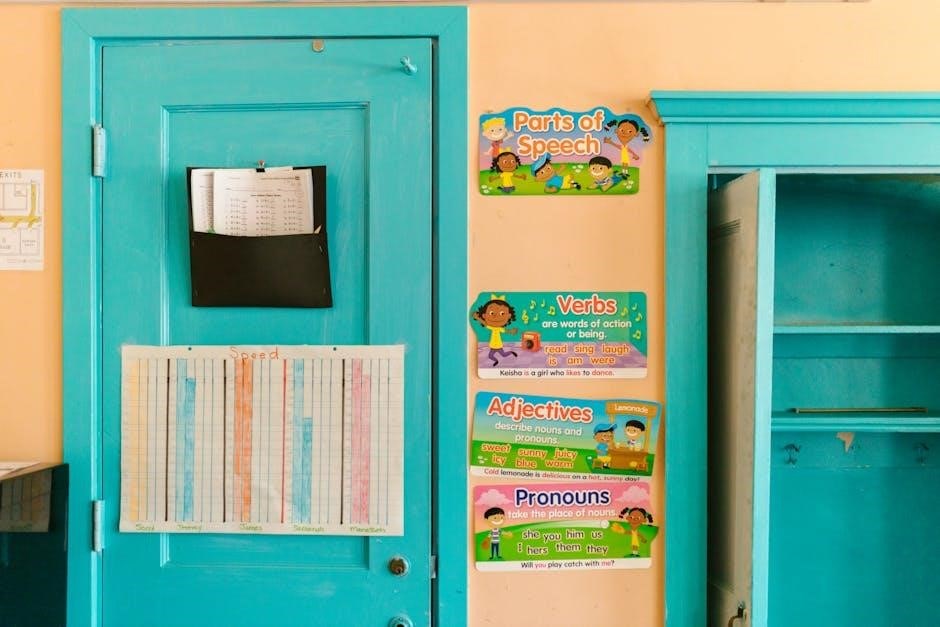
guided reading levels chart
Guided reading levels chart is a tool used to support literacy instruction, providing a comprehensive framework for teaching reading skills and strategies to students, with a focus on small-group instruction and assessment․
Purpose of Guided Reading Programs
Guided reading programs are designed to support a comprehensive literacy program by integrating small-group instruction, assessment, and independent practice into the classroom․ The purpose of these programs is to foster independent learners through challenging texts and opportunities for problem solving․ By using guided reading programs, teachers can help students build vocabulary, comprehension, and fluency skills․ These programs provide a framework for teaching reading skills and strategies to students, and are an important part of literacy instruction․ They offer a way to differentiate instruction and meet the needs of diverse learners․ Guided reading programs are also designed to be flexible and adaptable, allowing teachers to adjust instruction to meet the needs of their students․ Overall, the purpose of guided reading programs is to provide a supportive and structured approach to teaching reading, and to help students become confident and proficient readers․ Guided reading programs are essential for student success․

Understanding Guided Reading Levels
Guided reading levels are a system to organize reading skills and strategies, helping readers progress and develop fluency and comprehension abilities gradually and consistently over time always․
Importance of Guided Reading Levels
The importance of guided reading levels lies in their ability to provide a framework for teachers to assess and instruct students, helping to identify areas of strength and weakness, and informing instruction to meet the diverse needs of students․ Guided reading levels also help to ensure that students are challenged and engaged, as they progress through the levels, developing their reading skills and strategies․ By using guided reading levels, teachers can create a more personalized and effective reading program, tailored to the needs of each student, and ultimately leading to improved reading outcomes and a lifelong love of reading․ This approach supports a comprehensive literacy program, integrating small-group instruction, assessment, and independent practice, to foster independent learners and promote academic success․ Guided reading levels are essential for creating a supportive and inclusive reading environment․

Guided Reading Levels Comparison Chart
Guided reading levels comparison chart provides a framework for comparing different leveling systems, including Lexile and Fountas and Pinnell levels, to support informed instruction and assessment decisions always․
Reading Level Comparison
A reading level comparison is essential to understand the different leveling systems used in guided reading, including Lexile, Fountas and Pinnell, and Developmental Reading Assessment (DRA) levels, to support informed instruction and assessment decisions․
The comparison chart provides a framework for educators to navigate the various leveling systems, ensuring that students are challenged and supported appropriately․
By comparing reading levels, educators can identify areas where students may need additional support or enrichment, and make data-driven decisions to inform instruction․
The reading level comparison chart is a valuable tool for educators, providing a comprehensive overview of the different leveling systems and facilitating effective instruction and assessment․
The chart enables educators to compare and contrast the different levels, ensuring that students are placed appropriately and receive targeted support․
This comparison is crucial in supporting student learning and promoting academic success․
Educators can use the comparison chart to develop a deeper understanding of the leveling systems and make informed decisions․

Leveled Reading Systems
Leveled reading systems provide a framework for teaching reading, using various levels to support student learning and progression, with a focus on different reading skills and strategies development․
Types of Leveled Reading Systems
There are several types of leveled reading systems, including the Fountas and Pinnell system, Lexile levels, and Developmental Reading Assessment (DRA), each with its own unique characteristics and methods of measuring reading proficiency․ These systems provide a framework for teachers to assess student reading levels and tailor instruction to meet individual needs; The Fountas and Pinnell system, for example, uses a letter-level system to indicate reading proficiency, while Lexile levels use a numerical scale․ The DRA system, on the other hand, uses a combination of numerical and descriptive levels to assess reading proficiency․ Understanding the different types of leveled reading systems is essential for teachers to effectively use guided reading levels charts and support student reading development․ By using these systems, teachers can create a personalized reading program that meets the unique needs of each student․ Effective use of these systems requires ongoing professional development and training․

Using the Guided Reading Levels Chart
Teachers use guided reading levels chart to assess student reading levels and plan instruction, providing a framework for small-group instruction and independent practice, with accessible texts․
Interpreting the Chart
To interpret the guided reading levels chart, teachers need to understand the different leveling systems, including Fountas and Pinnell, Lexile, and DRA, and how they correspond to grade levels and reading skills․ The chart provides a framework for assessing student reading levels and planning instruction, with each level representing a range of reading skills and strategies․ By analyzing the chart, teachers can identify areas where students need additional support or enrichment, and develop targeted instruction to meet their needs․ The chart also helps teachers to select texts that are at the appropriate level for their students, ensuring that they are challenged but not frustrated․ With practice and experience, teachers can use the guided reading levels chart to inform their instruction and help students make progress in their reading development, ultimately leading to improved reading outcomes․ Effective interpretation of the chart is crucial for successful implementation․
Guided reading levels chart supports literacy instruction and student reading development effectively always․
Benefits of Guided Reading Levels Chart
The guided reading levels chart offers numerous benefits to students, teachers, and parents, including improved reading accuracy, fluency, and comprehension․ By using this chart, teachers can identify areas where students need extra support and provide targeted instruction․ The chart also helps to track student progress over time, allowing teachers to adjust their instruction to meet the needs of their students․ Additionally, the guided reading levels chart provides a framework for differentiated instruction, enabling teachers to tailor their teaching to meet the diverse needs of their students․ Overall, the guided reading levels chart is a valuable tool that supports student reading development and helps to foster a love of reading in students․ The chart is also useful for parents, who can use it to support their child’s reading development at home․ It is a useful resource for anyone involved in teaching reading․
Related Posts

jewelcrafting guide cata
Ready to become a jewelcrafting master in Cataclysm? Our guide makes leveling a breeze. Get the best gems and earn gold! Dive into Cata Jewelcrafting now!

neoquest 2 guide
Get the best NeoQuest 2 tips and tricks in our ultimate guide, boost your gameplay now at Graphics Divine

otj draft guide
Discover the ultimate OTJ draft guide, expert tips, and tricks to improve your game at Graphics Divine